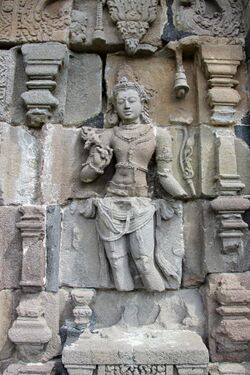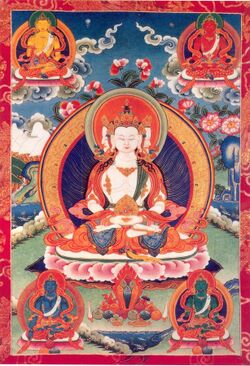Buddhas and bodhisattvas in art
Topic: Religion
 From HandWiki - Reading time: 5 min
From HandWiki - Reading time: 5 min
The many different varieties of Buddhist art often show buddhas and bodhisattvas, as well as depictions of the historical Buddha, known as Gautama Buddha (or Siddhārtha Gautama, Śākyamuni, or Tathāgata).
Especially in Mahayana Buddhism, the main image in a temple or shrine often does not represent the historical Buddha, although the situation is complicated by Buddhist teachings such as trikaya beliefs by which buddhas, including the historical buddha, have different manifestations.
Depictions could be Gautama, or a bodhisattva, guardian, protector, disciple, or saint. Clues to a figure's identity are found in, for example, the physical characteristics of the Buddha, the objects the figure is holding, its mudra (hand gesture), and asana (sitting or standing position of the body).[1] There may be an image in the figure's crown,[2] or the figure could be holding a book, thunderbolt, vase, jewel, or lotus flower or stem.[3]
Mandalas created for Japanese Shingon Buddhism and Tibetan Buddhism can contain hundreds of different figures that may need interpretation.[1][4] In his paper on the mudrās of bodhisattvas, Carl B. Becker, Kyoto University professor, describes the situation:
When the uninitiated observer first confronts the Buddhist pantheon [of Japan], his reaction may border on bewilderment or dismay. Far from the ascetic agnosticism taught by Gautama, Buddha-like deities are available to answer every material or spiritual need. They wear regal robes or deerskins; they sit, stand, or fly; they have their own sūtras, temples, and guardians....[5]
Dhyani Buddhas
Representations of the five Dhyani Buddhas, who are abstract aspects of Buddhahood rather than Buddhas or gods, have elaborate differences.[6] Each must face in a different direction (north, south, east, west, or center), and, when painted, each is a different color (blue, yellow, red, green, or white). Each has a different mudrā and symbol; embodies a different aspect, type of evil, and cosmic element; has a different consort and spiritual son, as well as different animal vehicles (elephant, lion, peacock, harpys or garuda, or dragon).[7]
Vairocana, the first Dhyani Buddha, embodying sovereignty and occupying the center,[7] is a special case (in any case, he is distinct from Gautama and not normally confused with him). He was one of the Buddhas of Bamiyan blown up by the Taliban which China mourned and tried to replace with the world's tallest statue, named Spring Temple Buddha.[8] Japanese Pure Land Buddhists think that Vairocana and the other Dhyani Buddhas are manifestations of Amitābha, but Japanese Shingon Buddhists think that Amitābha and the other Dhyani Buddhas are manifestations of Vairocana.[9]
Akshobhya, the second Dhyani Buddha who embodies steadfastness and faces east, and Gautama are indistinguishable. Both can be seated in the Vajraparyanka (also known as Bhūmisparśa) pose, with the right hand on the right knee, palm turned inwardly, and middle finger touching the ground.[7][10][11] Amitābha (Japanese: Amida) is the most ancient Dhyani Buddha, embodying light and facing west, and is the central figure in Pure Land Buddhism. A statue of Amitābha, when seated, has a samadhi mudrā with both palms face up, on top of each other, in his lap.[7][12][13]
Spring Temple Buddha picturing Vairocana, in Lushan County, Henan, China, is the world's second tallest statue.
Aksobhya, Tibet, 19th century, Honolulu Museum of Art
The Great Statue of Buddha Amitabha in Kamakura, Japan
Bodhisattvas
In early Buddhist art, bodhisattvas commonly appeared in pairs flanking Gautama Buddha as protective figures, usually at a smaller scale. But sometimes they were the main figure in an image, and they developed their own iconography. After about 600, they became increasingly prominent, and in art for Vajrayana uses began to replace images of the historical Buddha.
Images of Avalokiteśvara, the bodhisattva of compassion, might be mistaken for Gautama.[14] He is incarnated in the Dalai Lama, who is a tulku and the most revered Tibetan Buddhist monk.[15][16]
Especially among Westerners, Budai (in Chinese, or Hotei in Japanese) is often confused with Gautama or is thought to have originated Buddhism.[17] He is an incarnation of the bodhisattva and future Buddha, Maitreya,[18] who will come to Earth 4,000 years after Gautama disappears.[19] His name means "Cloth Sack" for the bag of sweets he carries, eats and gives to children. Admired for his happiness and contentment,[18] he is known in Chinese as "The Laughing Buddha" and sometimes in English as "The Fat Buddha".
Maitreya incarnated as Budai, The Laughing Buddha, in the Feilai Feng Caves, China
Avalokiteśvara on an altar in North Gyeongsang Province, Korea
Avalokiteśvara, Nepal, 14th century
Gautama
Gautama might have representations in a hundred different attitudes or positions, of which four follow.[20]
Gautama, with his hands in the dharmachakra or teaching mudrā. Sarnath Museum, India
Buddha attaining Parinirvana. Statue excavated at the Mahaparinirvana Temple in Kushinagar, Uttar Pradesh, India
See also
- Iconography of Gautama Buddha in Laos and Thailand
References
- Hawkins, Bradley K. (1999). The Pocket Idiot's Guide: Buddhism. Laurence King (Penguin, Alpha). ISBN 0-02-864459-X.
- Sakya, Jnan Bahadur (compiler) (2002). Short Description of Gods, Goddesses and Ritual Objects of Buddhism and Hinduism in Nepal (10th [reprint] ed.). Handicraft Association of Nepal. ISBN 99933-37-33-1.
- Sjoquist, Douglas P. (Winter 1999). "Identifying Buddhist Images in Japanese Painting and Sculpture". Education About Asia (Association for Asian Studies) 4 (3). http://aas2.asian-studies.org/EAA/EAA-Archives/4/3/278.pdf.
Notes
- ↑ 1.0 1.1 Sjoquist
- ↑ Sakya, p. 34.
- ↑ Sakya, various.
- ↑ "Exploring the Mandala". Cornell University Program of Computer Graphics. http://www.graphics.cornell.edu/online/mandala/. Retrieved January 22, 2012.
- ↑ Becker, Carl B. (December 1993). "Hands of the Bodhisattva The Standardization of Mudrās in Japanese Buddhist Sculpture Prior to A.D. 1200". East and West (Istituto Italiano per l'Africa e l'Oriente [IsIAO]) 43 (1/4): 199–232.
- ↑ Sakya, pp. 35, 76.
- ↑ 7.0 7.1 7.2 7.3 Sakya, p. 76.
- ↑ "China enters biggest Buddhist statue race". BBC News. http://news.bbc.co.uk/2/hi/world/monitoring/media_reports/1315785.stm. Retrieved March 3, 2012.
- ↑ Getty, Alice (1914). The gods of northern Buddhism: their history, iconography and progressive evolution through the northern Buddhist countries. Oxford Clarendon Press via Internet Archive. p. 3. https://archive.org/stream/northernbuddhism00gettuoft#page/n73/mode/2up.
- ↑ "The Lotus Sutra focus on Śākyamuni also fits the main Buddha figure in Zen, rather than the Buddhas Amida or Vairocana venerated in the contemporary Pure Land and Esoteric (and Kegon) movements." in Taigen Dan Leighton (2005). "Dōgen's Appropriation of Lotus Sutra Ground and Space". Japanese Journal of Religious Studies (Nanzan University) 32 (1): 87. doi:10.1093/acprof:oso/9780195320930.003.0004.
- ↑ "One of the two wives of Songtsen Gampo, she brought a large image of either Shakyamuni or Akshobhya Buddha (they are visually indistinguishable)..." in "Glossary (Balza, Balmoza)". The Huntington Archive, Ohio State University. http://kaladarshan.arts.ohio-state.edu/resources/downloads/COBGlossaryA-L.pdf. Retrieved January 22, 2012.
- ↑ Sakya, p. 30.
- ↑ Similarities with Amitabha in "Who's Who of Buddhism". Vipassana Foundation. http://www.thedhamma.com/whos_who.htm. Retrieved January 14, 2011.
- ↑ The Laughing Buddha and Avalokitesvara in "Maitreya: The Future Buddha". http://www.buddhanet.net/e-learning/history/maitreya2.htm. and "Mi-Lo-Fwo: Maitreya Buddha". Buddha Dharma Education Association and BuddhaNet. http://www.buddhanet.net/e-learning/history/maitreya-txt.htm. Retrieved January 15, 2011.
- ↑ Hawkins, pp. 66, 109.
- ↑ Incarnated as Dalai Lama in "From Birth to Exile". The Office of His Holiness the Dalai Lama. http://www.dalailama.com/biography/from-birth-to-exile. Retrieved January 15, 2011.
- ↑ "Who's Who of Buddhism". Vipassana Foundation. http://www.thedhamma.com/whos_who.htm. Retrieved January 14, 2011.
- ↑ 18.0 18.1 "The joy of belief". The Economic Times. Bennett, Coleman & Co.. January 31, 2012. http://articles.economictimes.indiatimes.com/2012-01-31/news/31010485_1_monk-sweets-bag. Retrieved March 2, 2012.
- ↑ Sakya, p. 43.
- ↑ Romero, Jay. Buddha Statues. The Buddha Garden. http://www.thebuddhagarden.com/buddha-statues.html. Retrieved March 4, 2012.
External links
Slides
- Huntington, John C.. "Mudras in Pan-Asian Buddhism, Part 1: Primary Mudras of the Major Buddhas". SlideShare. http://www.slideshare.net/UnitB166ER/mudra-in-asian-buddhism-primary-mudras-of-the-major-buddhas-by-john-c-hungtington.
- Coutu, Earnest. "Buddhist Mudras". SlideShare. http://www.slideshare.net/UnitB166ER/buddhist-mudras.
 |
 KSF
KSF










